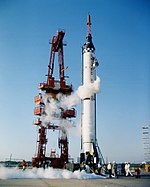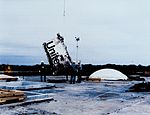Air Force Space and Missile Museum

The Air Force Space and Missile Museum is located at Launch Complex 26 at Cape Canaveral Space Force Station, Florida. It includes artifacts from the early American space program and includes an outdoor area displaying rockets, missiles, and space-related equipment chronicling the space and missile history of the US Air Force, the US Space Force and other military branches.The museum is accessible to the public as a part of the "Cape Canaveral Early Space Tour" offered by the Kennedy Space Center Visitor Complex four days per week. Free tours were also offered by the former Air Force 45th Space Wing Community Relations office until June 2013. The 45th Space Wing became Space Launch Delta 45 in May 2021 following establishment of the Space Force. The Sands Space History Center, a companion to the museum, is open to the general public six days a week. The History Center is located just outside the south gate of Cape Canaveral Air Force Station.
Excerpt from the Wikipedia article Air Force Space and Missile Museum (License: CC BY-SA 3.0, Authors, Images).Air Force Space and Missile Museum
Pad A,
Geographical coordinates (GPS) Address Nearby Places Show on map
Geographical coordinates (GPS)
| Latitude | Longitude |
|---|---|
| N 28.444166666667 ° | E -80.571111111111 ° |
Address
Launch Complex 26
Pad A
Florida, United States
Open on Google Maps






